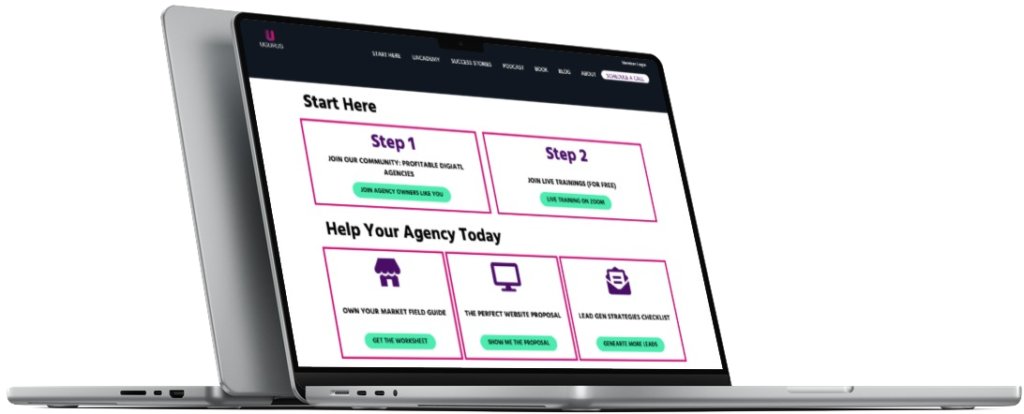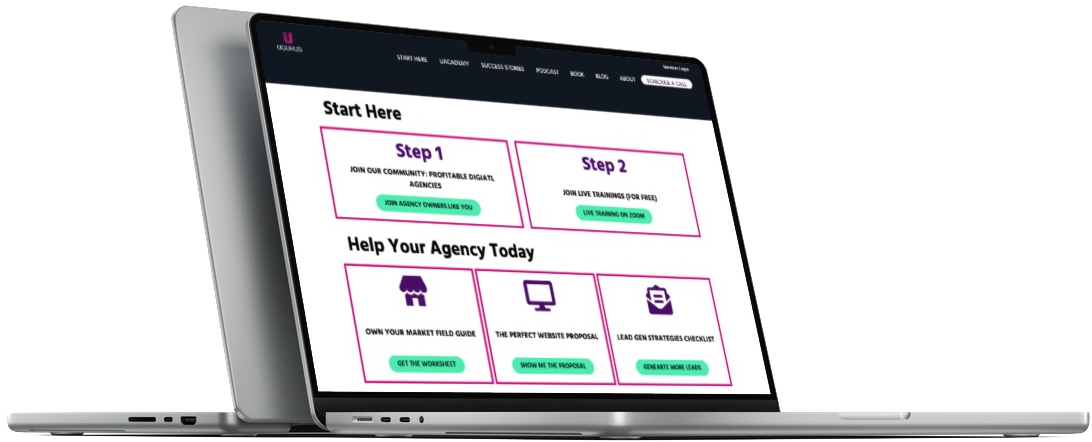Just like the meetings in your sales process, your delivery meetings need a “pulse”. This simple solution ensures you deliver and delight at every stage.
The Deliver and Delight system is the third super important system that I teach during UACADEMY Bootcamp.
How are you going to deliver on the promises that you made to the client during the sales process?
More importantly, how are you going to ensure your delivery delights the client and keeps them excited?
It’s a tough nut to crack because there are all sorts of struggles you’ll run into during the delivery process. You’ve got to juggle so many balls and make sure you’re not dropping any. You may have to deal with scope creep and managing client expectations.
Then there’s the final presentation. You want to present the project in a way that’s going to get the client really excited about it.
I have 5 Hot Principles for delivering and delighting.
We’re going to cover one of those here – creating your meeting pulse.
I’m going to dig into that in a moment. First, let’s look at what a better delivery process offers to your agency.
The Benefits of Better Delivery
How would it benefit you if you had a better delivery process?
You’re going to have less stress and better cash flow. You’ll also be able to move things forward a lot faster. If you have a client who has the potential to recur, you’ll get them to that point a lot quicker with a great delivery process.
For example, let’s say you offer digital marketing services as well as website design. Better delivery means you get that website live faster. And that means you can move the client onto the recurring marketing services faster.
Plus, you’ve delighted them with the website build so they’re more likely to say “yes” to that recurring service.
You keep the client happy, you get paid faster, and you create new opportunities.
Creating Your Regular Standing Meeting, or “Meeting Pulse”
Your meeting pulse is the first thing that you need to establish.
At the core of every project is a regular meeting that drives results, projects, deadlines, feedback, and accountability.
You need a meeting pulse with a fixed agenda. This keeps you in control of the project so that delays are unlikely to happen. And if they do, they’re controlled and your client’s on board with them every step of the way.
If you’re doing a 12-week project, you should have 12 weekly standing meetings.
Why Weekly Standing?
Let me tell you a story about my hair.
Trust me…I’m going somewhere with this.
So, I’ve got a guy who cuts my hair for me. I’ll go to him and get a cut. Then, about five weeks later, my hair’s a bit shaggy and it needs the scissor treatment again.
I call my guy and let him know I want to book an appointment. And he tells me that he can’t fit me in right now but he’s got a slot in two weeks.
During those two weeks, my hair’s going to get shaggier and it’s going to look worse by the time I get to the barber.
Now, think about how that applies to your project.
Say you hit an important milestone for the project. You call the client up all excited on Monday and tell them that you’re ready to move things forward.
You ask, “Can you meet on Wednesday?”
The client looks at their calendar and says no. They’re taking their kids to the game on Wednesday.
They say, “What about Friday?”
You look at your calendar and Friday’s fully booked. There’s no way you can slot another meeting in.
The conversation goes back and forth until you settle on a meeting a week from Tuesday.
The job’s done, right?
Here’s what just happened – you’ve wasted six working days.
The project can’t move forward until you’ve had the meeting to sign off on the achievement of the milestone. That means you’re waiting around and twiddling your thumbs until the client’s free for the meeting.
The weekly standing meeting averts all of that. You have a set time and place where you meet once per week. You’ll go over the project and move things forward a lot faster.
That means you deliver better results quicker.
The Accountability Issue
Weekly standing meetings also keep your clients accountable.
UGURUS’ client Brandy L. highlights one of the many issues that clients can cause with projects.
Brandy runs a digital agency that also offers content creation services.
She ran into the same question from many of her clients: why should we get you to create content when we can do it ourselves?
Brandy knew the answer to that question. The clients likely wouldn’t deliver the content on time and wouldn’t hit the right level of quality.
Regular meetings could help her to resolve the problem.
How, you might ask?
With a weekly meeting, you have a forum to bring something up when the client drops the ball. If they’re supposed to deliver content, you can call them out for not doing it. If it happens for a couple of weeks, you can point to the lack of delivery.
And you can use that to point them in the direction of a service that will keep the project moving forward.
Of course, this works both ways. If you’ve got a set time for a meeting, you know you’ve got to work like crazy to hit your deliverables for the week.
Both you and your client stay accountable. And that means you’re delivering a result that delights. And you’re doing it all a lot faster.
The 4-Point Meeting Agenda
You’ve got the weekly meeting booked.
Now, you need to know what it should cover. I break my weekly meetings down into a 4-point agenda to ensure they maintain a good pulse.
Point #1 – The Victories
This is where you look back at what you achieved the previous week.
Examples include:
- Clearing a milestone.
- Approving or presenting a deliverable.
- Reaching a decision with the client.
These are all little victories that keep the project moving forward. Take a little time to cover them so you immediately point to the progress that the project’s made.
Point #2 – The Issues
No project’s going to go perfectly. You’ll hit some issues along the way that you’ll need to cover in your meetings.
This is where you talk about where you or the client fell short last week. On the client’s side, the failure to deliver content on time would fall into this portion of the meeting. Other examples include:
- Any late deliverables from your end.
- Delayed feedback and poor communication.
- Any unmanaged changes in the project’s scope.
That last one’s especially important. Any change to the project’s scope almost inevitably leads to delays and other issues. If you’re not managing those changes, you’re going to run into issues.
Happily, I cover how to manage scope changes in the fourth point. But before that, you’ll cover…
Point #3 – Priorities
What do you and the client need to get done next week to keep the project moving forward?
At this stage, you’re likely going to present a deliverable and agree on a deadline for it. You’ll also go over any feedback that the client has regarding previous deliverables. You may need to revise some work before moving forward with another part of the project.
Point #4 – Metrics
If you have metrics for the project, this is where you measure them. For example, you’ll check which milestones you’ve reached and which are still outstanding.
You’ll also set all of your deadlines for the week ahead here.
Finally, there’s the issue of scope changes, which I mentioned earlier. Scope creep is one of the big problems that a lot of agencies run into.
You’ll literally build scope changes into your agenda to avoid the problem.
Imagine that you go into your first client meeting. At the very end, you ask “Do we have any scope change orders?”
The client says “no” and you all carry on.
But you’re training your client to start thinking about scope. Specifically, are you in scope or out of scope?
When the out-of-scope items come up later, you now have context and a framework to enable that conversation. It’s not some crazy thing that comes out of left-field anymore. The client understands what a scope change is and how they go about adding something to their wish list.
Delivering to Delight
With a meeting pulse created, projects move forward a lot quicker. They don’t get shaggy and you don’t fall out of alignment with your client in terms of what you need to deliver.
The awesome thing here is that you’re catching potential issues earlier too. The 4-point agenda covers all of the bases so that everyone leaves the meeting knowing what the next step is.
Of course, this is only the first of my 5 Hot Principles for the Deliver and Delight system. There’s a lot more I can show agency owners and freelancers about scaling and getting bigger projects.
You can join UACADEMY to learn more. Apply online today to see if you qualify for a FREE strategy session with UGURUS.
GET YOUR FREE AGENCY ACCELERATOR PACKAGE






